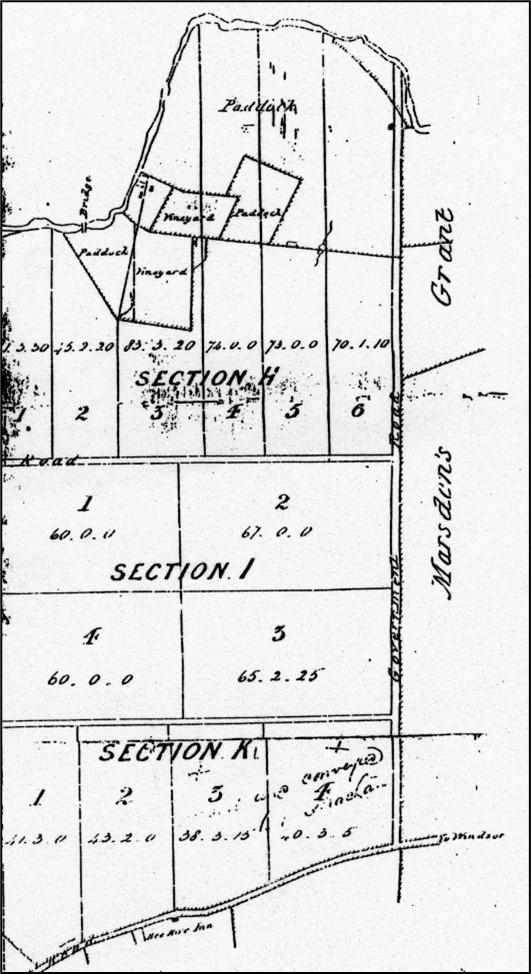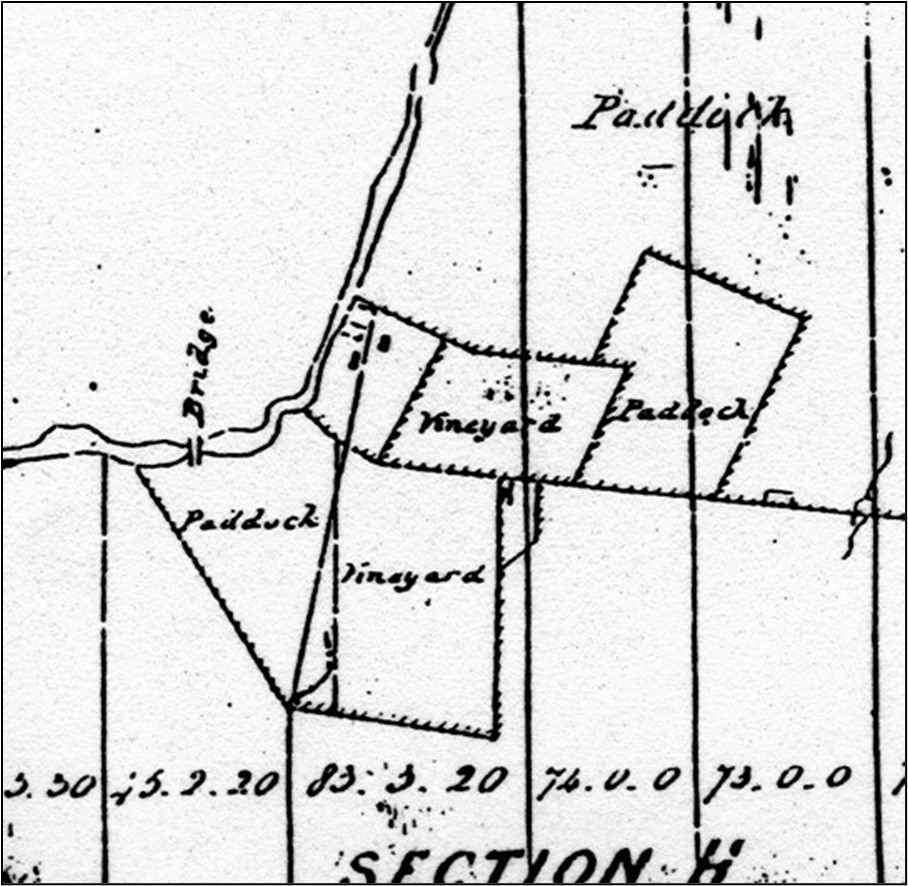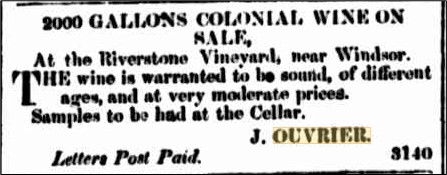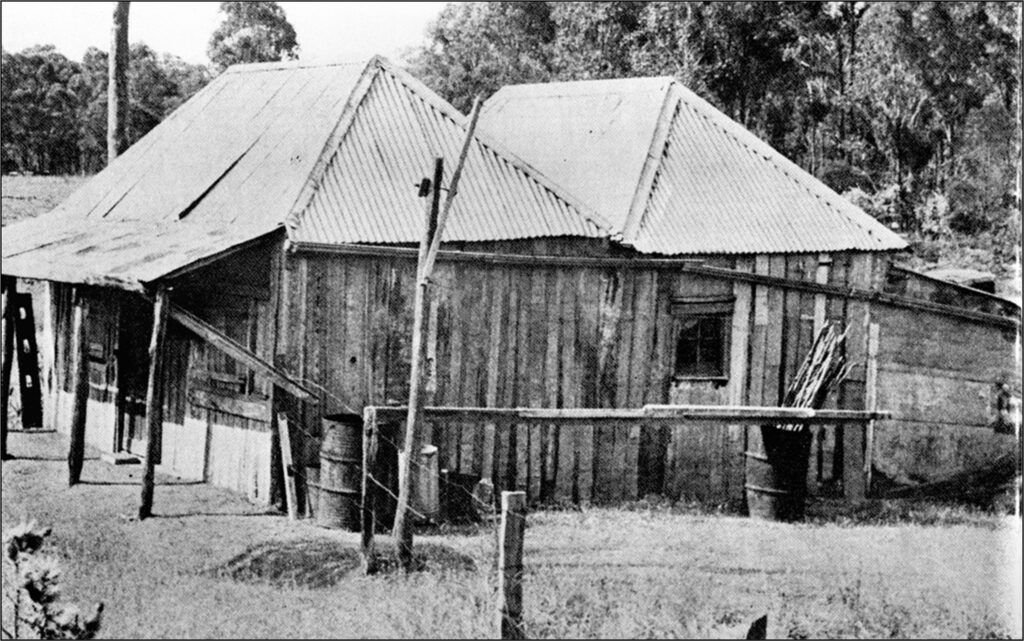by Ron Mason
20th March 2016
In July 1841, at a time when the O’Connell’s Riverston Estate was essentially an unfenced grazing property and long before the existence of the village of Riverstone, Sir Maurice O’Connell engaged two French vinedressers, Jules Vaillant and Jean Antonie Ouverier to prepare the ground for, and plant a vineyard at his Riverston, property.


The two Frenchmen commenced work immediately and soon they and their workmen had prepared three acres of land and planted 5000 vines. These were the first grapes to be planted in the district and although the vines flourished the relationship between O’Connell and the vinedressers did not. O’Connell took action against Vaillant for the non payment for a horse that O’Connell had sold him. Vaillant’s response was that he expected the cost of the horse to be deducted from the money owed to them for the work they had undertaken. Vaillant and Ouverier then took joint legal action against O’Connell for non payment for their services. Not surprisingly this action was unsuccessful.
These events ended the Frenchmen’s involvement with O’Connell but it would seem that they had done their work well for in 1844 it was reported that “several of our gentry attended at Riverston, on the Parramatta road, the property of His Excellency Lieutenant General Sir Maurice O’Connell, for the purpose of witnessing the sale of a part of the same by auction, … they proceeded through His Excellency’s splendid estates of Mount Macquarie and Riverston, to the vineyard on the eastern creek, where a substantial repast, provided by the host of the Daniel O’Connell Inn, awaited them.”
O’Connell’s land did not sell at this time. However, the vineyard appears to have flourished and even expanded and throughout the 1850s and 60s there are references to it, one notably describing it as consisting “of the very best description of grapes.”
In the meantime Jules Vaillant had departed the Colony for Tahiti. However, Jean Ouverier, or as he now anglicised his name, John Peter Ouvrier, choose to settle in the area and establish his own vineyard. This is confirmed by a firsthand account given by T. C. M. Hyland in 1906. According to Hyland “Many years ago the late Mr. Ouvrier (father of Messrs Charles, John, and James Ouvrier) owned and worked a large vineyard in this locality. During the grape season this vineyard, being the most important convenient to Windsor, was a great resort of the Windsor people, who always spoke of going out to “The Vineyard,” which eventually became the recognised name for this part of the district. Some time ago, when I succeeded in having the local receiving office converted into a post office, and when we were enjoying the novelty of seeing ‘The Vineyard’ post mark on our letters, the district Progress Association represented that ‘Vineyard’ alone would be a more suitable name for the post office. This name it now bears, though the local public school still retains the original name — The Vineyard — which most of the residents use, and the euphony of which is apparent.”
Ouvrier’s vineyard was indeed significant in size and production. In 1851 he advertised that he had “2000 GALLONS COLONIAL WINE ON SALE, At the Riverstone Vineyard, near Windsor. THE wine is warranted to be sound, of different ages, and at very moderate prices. Samples to be had at the Cellar.”

Hyland’s account is collaborated by the later recollections of Thomas Davis who wrote “56 Years Ago [in 1878] When I first came to Riverstone Mr. Charles Ouvrier’s father had a fine grape vineyard on Bald Hill, now known as Vineyard Hill. Mr. Charles Ouvrier, who was born on the property is still going strong at the age of 76 years, during the whole of which period he has never been away from the district. The late Mr. Thomas Schoffel’s father took over the vineyard from Mr. Ouvrier on lease.”
However, fifty years after the first vines were planted virtually all of vineyards in the area were wiped out by the Phylloxera mite. Notwithstanding this, the locality is still known as ‘The Vineyard’.
Quite some years earlier than these events John Ouvrier had married a local girl, Ann Hynds, from Box Hill and reared their family at ‘The Vineyard’. He died in 1884 at the age of 79 years and was survived by his wife who lived on in the family home until her death in 1918. According to her obituary “They had a family of stalwart sons and daughters, all of whom are very highly respected, throughout the Hawkesbury district. There are no more honorable people than the Ouvriers — as straight as a gun barrel, all of them, and with a healthy contempt for anything crooked mean or despicable.”

Three of their sons, Charles, James and John continued to live in the Riverstone district for many more years. James and John both operated local sawmills and both prospered. Both also had a son killed during the First World War. James’ son, Alfred Joseph Ouvrier, was killed on the Western Front on 14th September 1918. His death is recorded on the Riverstone War Memorial.
